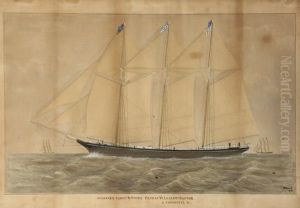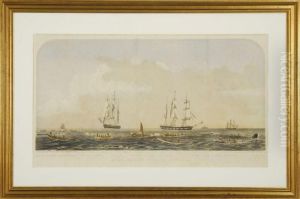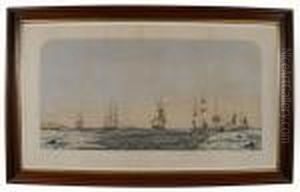Benjamin Russell Paintings
Benjamin Russell was an American artist, notably recognized for his work as a maritime painter, born in 1804 in New Bedford, Massachusetts, a hub of the whaling industry during the 19th century. His life and art were deeply influenced by the sea and whaling, which were integral to the economy and culture of New England at the time. Unlike many artists of his era who trained in Europe or at established art schools, Russell's education in art came from his firsthand experiences at sea and his innate talent.
In 1821, at the age of 17, Russell embarked on a whaling voyage that lasted four years. This journey provided him with a wealth of experiences and images that he would later translate into his art. After returning to New Bedford, he began his artistic career, initially focusing on scrimshaw, a form of engraving on whalebone or ivory, before transitioning to painting. His works primarily depict scenes of whaling voyages, whale hunts, and portraits of ships, offering a vivid glimpse into the life and industry of the period.
Russell is perhaps best known for his collaboration with Caleb Purrington, with whom he created the grand panorama "Whaling Voyage Round the World" in the 1840s. This massive work, measuring over 1,000 feet in length, was a moving panorama that traveled and was displayed in various cities, providing audiences with a visual narrative of a whaling voyage. This panorama is considered one of his most significant contributions to American art and maritime history.
Despite the specificity of his subjects, Russell's work transcends mere documentation of the whaling industry; it captures the drama and enormity of the sea and the creatures within it, reflecting broader themes of man's relationship with nature. His paintings are characterized by attention to detail, accuracy in the depiction of ships and sea life, and a palpable sense of adventure and peril.
Benjamin Russell passed away in 1885 in his hometown of New Bedford. Today, his works are held in high esteem and can be found in various institutions, including the New Bedford Whaling Museum, reflecting his enduring legacy as a key figure in American maritime art and providing invaluable insights into the era's whaling culture.


